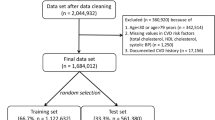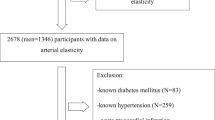Abstract
It has been demonstrated that aortic stiffness is an independent predictor of cardiovascular disease. We investigated whether this measure is of use in cardiovascular risk stratification in clinical practice for elderly subjects (mean age 71.5 years). Within the framework of the Rotterdam Study, we stratified subjects free of coronary heart disease (CHD) at baseline into categories of low (<10%), intermediate (10–20%) and high (>20%) 10-year risk of CHD based on Framingham risk factors. Within each risk category, we determined the percentages of subjects moving into a higher or lower risk category when adding aortic stiffness to the Framingham risk factors. Among 2849 participants, 223 CHD events occurred during a median follow-up of 7.9 years. In the low risk group, 5% of the subjects could be reclassified and in the high-risk group, 6% of the subjects could be reclassified to the intermediate-risk group. In the intermediate-risk group 3% could be reclassified to the high-risk group and 6% to the low-risk group. In a population of elderly subjects, aortic stiffness measurement in addition to Framingham risk factors leads to a limited reclassification of subjects in 10-year cardiovascular disease-risk categories. Therefore, aortic stiffness is associated with the risk of CHD in elderly, but provides no additional value in cardiovascular risk stratification.
This is a preview of subscription content, access via your institution
Access options
Subscribe to this journal
Receive 12 digital issues and online access to articles
$119.00 per year
only $9.92 per issue
Buy this article
- Purchase on Springer Link
- Instant access to full article PDF
Prices may be subject to local taxes which are calculated during checkout


Similar content being viewed by others
References
Conroy RM, Pyorala K, Fitzgerald AP, Sans S, Menotti A, De Backer G et al. Estimation of ten-year risk of fatal cardiovascular disease in Europe: the SCORE project. Eur Heart J 2003; 24 (11): 987–1003.
Expert Panel on Detection EaToHBCiA. Executive Summary of The Third Report of The National Cholesterol Education Program (NCEP) Expert Panel on Detection, Evaluation, And Treatment of High Blood Cholesterol In Adults (Adult Treatment Panel III). Jama 2001; 285 (19): 2486–2497.
Mattace-Raso FU, van der Cammen TJ, Hofman A, van Popele NM, Bos ML, Schalekamp MA et al. Arterial stiffness and risk of coronary heart disease and stroke: the Rotterdam Study. Circulation 2006; 113 (5): 657–663.
Sutton-Tyrrell K, Najjar SS, Boudreau RM, Venkitachalam L, Kupelian V, Simonsick EM et al. Elevated aortic pulse wave velocity, a marker of arterial stiffness, predicts cardiovascular events in well-functioning older adults. Circulation 2005; 111 (25): 3384–3390.
Laurent S, Cockcroft J, Van Bortel L, Boutouyrie P, Giannattasio C, Hayoz D et al. Expert consensus document on arterial stiffness: methodological issues and clinical applications. Eur Heart J 2006; 27 (21): 2588–2605.
Mancia G, De Backer G, Dominiczak A, Cifkova R, Fagard R, Germano G et al. 2007 Guidelines for the Management of Arterial Hypertension: The Task Force for the Management of Arterial Hypertension of the European Society of Hypertension (ESH) and of the European Society of Cardiology (ESC). J Hypertens 2007; 25 (6): 1105–1187.
Hofman A, Breteler MM, van Duijn CM, Janssen HL, Krestin GP, Kuipers EJ et al. The Rotterdam Study: 2010 objectives and design update. Eur J Epidemiol 2009; 24 (9): 553–572.
Asmar R, Benetos A, Topouchian J, Laurent P, Pannier B, Brisac AM et al. Assessment of arterial distensibility by automatic pulse wave velocity measurement. Validation and Clinical Application Studies Hypertension 1995; 26 (3): 485–490.
Expert Committee on the Diagnosis and Classification of Diabetes Mellitus. Report of the Expert Committee on the Diagnosis and Classification of Diabetes Mellitus. Diabetes Care 1997; 20 (7): 1183–1197.
Meijer WT, Hoes AW, Rutgers D, Bots ML, Hofman A, Grobbee DE . Peripheral arterial disease in the elderly: The Rotterdam Study. Arterioscler Thromb Vasc Biol 1998; 18 (2): 185–192.
Kardys I, Kors JA, van der Meer IM, Hofman A, van der Kuip DA, Witteman JC . Spatial QRS-T angle predicts cardiac death in a general population. Eur Heart J 2003; 24 (14): 1357–1364.
WHO. International Statistical Classification of Diseases and Related Health Problems 10 ed. WHO: Geneva, 1992.
Nagelkerke N . A note on a general definition of the coefficient of determination. Biometrika 1991; 78 (3): 2.
Ash A, Shwartz M . R2: a useful measure of model performance when predicting a dichotomous outcome. Stat Med 1999; 18 (4): 375–384.
Harrell F . Regression Modeling with Application to Linear Models, Logistic Regression and Survival Analysis. New York, NY: Springer-Verslag, 2001.
Efron BTR . An Introdution to Bootstrap. Chapman & Hall: New York, 1993.
Steyerberg EW . Clinical Prediction Models. Springer: New york, NY, 2009.
Cook NR, Buring JE, Ridker PM . The Effect of Including C-Reactive Protein in Cardiovascular Risk Prediction Models for women. Ann Intern Med 2006; 145 (1): 21–29.
Steyerberg EW, Pencina MJ . Reclassification calculations for persons with incomplete follow-up. Ann Intern Med 2010; 152 (3): 195–196;author reply 6–7.
Boutouyrie P, Tropeano AI, Asmar R, Gautier I, Benetos A, Lacolley P et al. Aortic stiffness is an independent predictor of primary coronary events in hypertensive patients: a longitudinal study. Hypertension 2002; 39 (1): 10–15.
Blacher J, Safar ME, Guerin AP, Pannier B, Marchais SJ, London GM . Aortic pulse wave velocity index and mortality in end-stage renal disease. Kidney Int 2003; 63 (5): 1852–1860.
Cruickshank K, Riste L, Anderson SG, Wright JS, Dunn G, Gosling RG . Aortic pulse-wave velocity and its relationship to mortality in diabetes and glucose intolerance: an integrated index of vascular function? Circulation 2002; 106 (16): 2085–2090.
Meaume S, Benetos A, Henry OF, Rudnichi A, Safar ME . Aortic pulse wave velocity predicts cardiovascular mortality in subjects >70 years of age. Arterioscler Thromb Vasc Biol 2001; 21 (12): 2046–2050.
van Popele NM, Mattace-Raso FU, Vliegenthart R, Grobbee DE, Asmar R, van der Kuip DA et al. Aortic stiffness is associated with atherosclerosis of the coronary arteries in older adults: the Rotterdam Study. J hypertens 2006; 24 (12): 2371–2376.
Mosterd A, Hoes AW, de Bruyne MC, Deckers JW, Linker DT, Hofman A et al. Prevalence of heart failure and left ventricular dysfunction in the general population; The Rotterdam Study. Eur Heart J 1999; 20 (6): 447–455.
Mitchell GF, Hwang SJ, Vasan RS, Larson MG, Pencina MJ, Hamburg NM et al. Arterial stiffness and cardiovascular events: the Framingham Heart Study. Circulation 2010; 121 (4): 505–511.
Ware JH . The limitations of risk factors as prognostic tools. N Engl J Med 2006; 355 (25): 2615–2617.
Chambless LE, Folsom AR, Sharrett AR, Sorlie P, Couper D, Szklo M et al. Coronary heart disease risk prediction in the Atherosclerosis Risk in Communities (ARIC) study. J Clin Epidemiol 2003; 56 (9): 880–890.
Koller MT, Steyerberg EW, Wolbers M, Stijnen T, Bucher HC, Hunink MG et al. Validity of the Framingham point scores in the elderly: results from the Rotterdam study. Am Heart J 2007; 154 (1): 87–93.
Acknowledgements
The study was supported by Grant IS042015 of SenterNovem (Ministry of Economic Affairs, The Netherlands) and by Esaote SpA, Genoa, Italy.
Author information
Authors and Affiliations
Corresponding author
Ethics declarations
Competing interests
Dr Reneman reports having served as a consultant for PIE Medical. The remaining authors report no conflict of interest.
Rights and permissions
About this article
Cite this article
Verwoert, G., Elias-Smale, S., Rizopoulos, D. et al. Does aortic stiffness improve the prediction of coronary heart disease in elderly? The Rotterdam Study. J Hum Hypertens 26, 28–34 (2012). https://doi.org/10.1038/jhh.2010.124
Received:
Revised:
Accepted:
Published:
Issue Date:
DOI: https://doi.org/10.1038/jhh.2010.124
Keywords
This article is cited by
-
Hypertensive Mediated Organ Damage and Hypertension Management. How to Assess Beneficial Effects of Antihypertensive Treatments?
High Blood Pressure & Cardiovascular Prevention (2020)
-
Frequency of early vascular aging and associated risk factors among an adult population in Latin America: the OPTIMO study
Journal of Human Hypertension (2018)
-
Total arterial compliance estimated by a novel method and all-cause mortality in the elderly: the PROTEGER study
AGE (2014)
-
On the Estimation of Total Arterial Compliance from Aortic Pulse Wave Velocity
Annals of Biomedical Engineering (2012)



